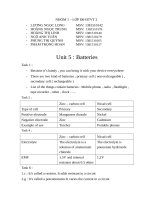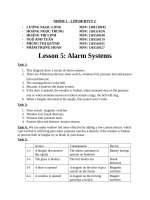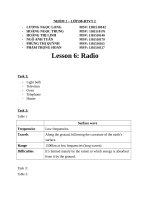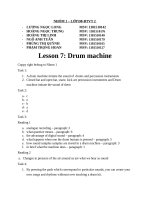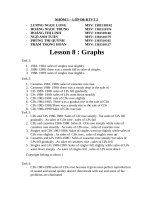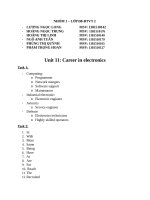ĐIỆN tử VIỄN THÔNG DTVT2 nhom4 bai9 txt khotailieu
Bạn đang xem bản rút gọn của tài liệu. Xem và tải ngay bản đầy đủ của tài liệu tại đây (60.69 KB, 5 trang )
Audio recording systems
D8-DTVT2
Group 4 :
Ngô Đắc Quân
Lê Văn Hoạch
Phùng Thế Quảng
Phạm Thị Minh Phượng
Nguyễn Thị Phương
Nguyễn Nhật Thư
Nguyễn Tuấn Anh
Ng ô Th ị Phượng
Task 1:Tuning-in
Try to answer these questions:
What problems are there with records?
- Some time it has a sound 'crackle' and after that the CD 'jumping' to the next song
although the old song hasn’t done yet.
What other recording systems are there?
- Optically recorded digital soundtrack
- Magnetic wire recorder
- Radio
What do these abbreviations mean?
A, LP: long-playing
B, CD: Compact Disc
Task 2: Read quickly through this text to check your answers to
Task 1.
Audio recording systems
For a long time hi-fi recordings have been produced on vinyl gramophone
records. Records use an analogue recording system, which stores patterns by
cutting a continuous groove in a vinyl disk. The shape of the sides of the
groove represents the audio pattern. The sound can be reproduced by
spinning the record and using the movement of a metal needle in the groove to
produce varying magnetic fields (see Fig. 1). These magnetic fields are then
processed to produce the sound. A typical LP (long-playing record) has a
recording capacity of about 45 minutes
A digital recording system, known as a compact disc (CD) system, was
introduced in 1982. This uses a laser optical mechanism in which a laser beam
reads marks on the surface of a specially prepared perspex disc. It gives nearperfect reproduction of sound and the sound quality does not deteriorate with
use. Some of the problems associated with vinyl records are eliminated such as
'crackle' caused by dust and static, and 'jumping', due to scratches on the
recording surface.
In a CD system, a recording is made by electronically sampling the sound
44,100 times every second. The electronic samples are used to control a laser
beam, which makes a pattern of very small pits in the surface of the perspex
disc. The audio pattern is represented by the length of the pits and the
distance between them. The pits are arranged in circular tracks. A typical CD
has about 20,000 circular tracks and a maximum recording capacity of 74
minutes.
To play back the recording, the disc is made to revolve at a constant speed and
a laser beam is directed at its surface. The varying reflection of the laser beam
is fed into a digital-to-analogue converter (DAC). This produces the electronic
signals, which are amplified to drive a loudspeaker.
Task 3: Use the text above to complete this table of differences
between LPs and CDs:
LPs
CDs
1 Recording system
analogue
digital
2 Sound quality
3 Access
poorer than the
original
serial
does not deteriorate with
use
random
4 Audio pattern
groove
pits
5 Material
6 Playing mechanism
vinyl
mechanical
perspex
7 Durability
easily damaged
durable
8 Size
12 inches
12cm
9 Playing time
45 minutes
74 minutes
Task 4:Items in List 1 can be causes or effects of items in List 2.
Match the pairs. Compare your answers with your partner.
List 1
1 distortion
2 noise generated within
a
b
List 2
interference on radios
too high a recording level
components
3 overheating a transistor
c
4 dirty heads
5 a build-up of oxide on the
head
6 jumping
7 unwanted signals
d
e
the tape rubbing against the
head
scratches on records
hiss
f
g
damage
poor recordings
1-b; 2-e; 3-f; 4-c; 5-a; 6-d; 7-g.
Task 6:Speaking practice
DCC (Digital Compact
Cassette – băng từ)
1
2
3
4
5
6
Recording system
magnetic tape
Sound quality
quality is the same
Access
laser and a magnetic field
Medium
Playing time
can play again
Advantages
backwards compatibility
MD (MiniDisc – đĩa
mini)
magneto-optical
quality is the same
laser and a magnetic field
can play again
it can immediately jump
to any part of the
recording rather than
having to play from the
beginning to the end
Task 7: Writing Linking facts and ideas, 3
Study this diagram, which explains the operation of automatic doors. Then
turn to the next page and link each set of statements using words or phrases of
your own to make your own explanation. Omit unnecessary words and make
any other changes required.
A microwave sensor monitors changes in the pattern of returning microwaves
produced as a beam by the transmitter horn. Movement through the beam changes
this pattern and, as an object or person approaches and disturbs the pattern, a signal
is sent for the door motor to start.
As the door starts to open, a safety beam comes on.This ensures that, as long as
there is a person within the door space, the door will not dose.

